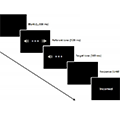Abstract
Performance is better when a high pitch tone is associated with an up or right response and a low pitch tone with a down or left response compared to the opposite pairs, which is called the spatial-musical association of response codes effect. The current study examined whether polarity codes are formed in terms of the variation in loudness. In Experiments 1 and 2, in which participants performed a loudness-judgment task and a timbre-judgment task respectively, the correspondence effect was obtained between loudness and response side regardless of whether loudness was relevant to the task or not. In Experiments 3 and 4, in which the identical loudness- and timbre-judgment tasks were conducted while the auditory stimulus was presented only to the left or right ear, the correspondence effect was modulated by the ear to which the stimulus was presented, even though the effect was marginally significant in Experiment 4. The results suggest that loudness produced polarity codes that influenced response selection (Experiments 1 and 2), and additional spatial codes provided by stimulus position modulated the effect, generating the stimulus eccentricity effect (Experiments 3 and 4), which is consistent with the polarity correspondence principle.
